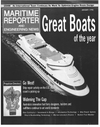
Page 46: of Maritime Reporter Magazine (January 1998)
Read this page in Pdf, Flash or Html5 edition of January 1998 Maritime Reporter Magazine
Foam Filled Marine Fenders w y j 'i I:* ' f ir' ~ X im-f t1 > r ^ ' ^
The Ultimate protector for ships, harbor craft, wharves & piers.
Construction complies with United States Navy and Coast Guard Specifications
Core consists of closed-cell, resilient, energy absorbing foam, covered with a protective, seamless polyurethane elastomer skin. Will not mark or scratch vessel hulls
Easy to install with very little maintenance.
Light Weight and Extremely buoyant with a lower reaction force than either hard rubber or pneumatic fenders (almost 40% higher energy absorption than pneumatic fenders) 1-800-913-0062
Urethane Products Corporation 17007 SOUTH BROADWAY • GARDENA, CA 90248
Tel: 310-532-3662 • Fax:310-532-9884
AUSTRALIAN MARITIME REVIEW
Complete Line of Foam-Filled Buoys
Circle 320 on Reader Service Card
AME Tackles International
Maritime Problems
The Australian Maritime
Engineering CRC, established in July 1992, aims to be a valuable resource for Australia's maritime and offshore engineering industry. It provides support and infrastructure for co- operative research and the facility for technology exchange. Its headquar- ters are in Launceston and a major node is located in Melbourne.
Current research programs focus on three principal areas: calm water performance of marine vehicles, ocean influence on ships and mar- itime structures, and structural design and fabrication of ships and mar- itime structures.
The CRC's research has worldwide implications. A current project involving BHP Transport, Lloyd's
Register of Shipping, Ishikawajima-
Harima Heavy Industries and P&O
Bulk Shipping Ltd., has interim find- ings on extending the safe life of bulk carriers. The results were recently presented at seminars in Sydney,
Tokyo and London. Further projects of significance include wind tunnel testing of scale models to measure ship resistance, a pipeline tow-out for a large petroleum company, hydro- mechanic loading of a bridge struc- ture and various other wave tank tests.
Circle 27 on Reader Service Card 46
Circle 311 on Reader Service Card (Continued from page 38) deployed to Canada under a six- month charter with Bay Ferries. It will operate 14 hours per day between Bar Harbour and Yarmouth.
The vessel is powered by four Ruston 20 RK270 conventional medium speed diesel engines which develop 7,080 kW (9,500 hp) each. Each engine drives a transom-mounted
Lips waterjet through a Renk reduc- tion gearbox.
To service such demanding routes,
Devil Cat is constructed from marine grade aluminum alloys. Incat has insisted on the earliest introduction of the rare 5383-H116 alloy — which the yard says will provide significant marine and mechanical property improvements over the superseded 5083 range. The internationally accepted 6082 T6 alloy is being used for extruded aluminum while Incat changes to the 5383 series alloy. The wave piercing catamaran was devel- oped by Incat in the early 1980s, and has undergone 15 years of refine- ment. The design is characterized by long, slender, waterborne hulls, each subdivided into eight watertight compartments, with very little buoy- ancy at the bow. As each hull encounters a wave, it tends to pierce through, rather than ride over it.
The aluminum superstructure is supported on vibration damping mounts. Passenger comfort is enhanced greatly with the hull shape and design itself, and even more so via a Maritime Dynamics Inc. ride control system.
The interior design was provided by Incat's in-house design group, and the mission to maximize onboard revenue potential while retaining a unique style was amply met.
Particular attention was paid to maximizing passenger comfort for the long fast ferry routes. The main deck contains two lounges, and TT-
Line plans to use the aft lounge as a mini cinema.
Wavemaster International, also of
Henderson, delivered a record- breaking nine vessels last year, including Hull Nos. 152 and 153 in
December. In addition to the nine,
Wavemaster currently has three more vessels under construction.
The latest deliveries are a pair of 102-ft (31-m) monohull high-speed ferries for Indonesian operator P.T.
Marina City Indah. Marina City
Indah is reportedly happy with the results of the sea trials, as well as the overall quality of construction, not to mention the build time of only eight months. The vessels achieved close to 30 knots during sea trials with simulated service deadweight
Maritime Reporter/Engineering News

 45
45

 47
47
